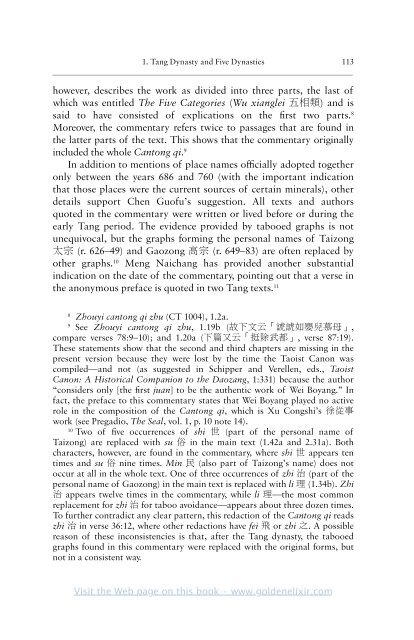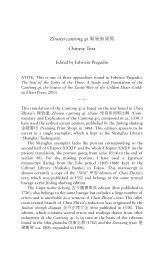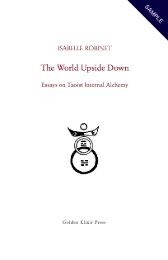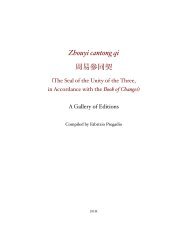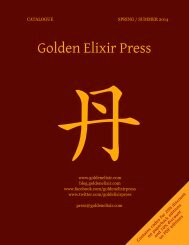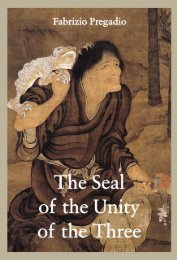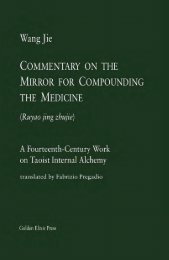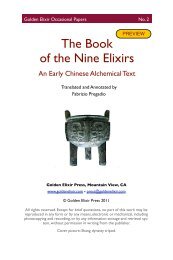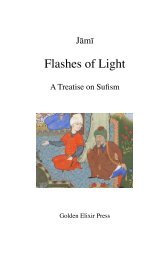The Seal of the Unity of the Three â Vol. 2 - The Golden Elixir
The Seal of the Unity of the Three â Vol. 2 - The Golden Elixir
The Seal of the Unity of the Three â Vol. 2 - The Golden Elixir
- No tags were found...
Create successful ePaper yourself
Turn your PDF publications into a flip-book with our unique Google optimized e-Paper software.
1. Tang Dynasty and Five Dynasties 113<br />
—————————————————————————————————————————<br />
however, describes <strong>the</strong> work as divided into three parts, <strong>the</strong> last <strong>of</strong><br />
which was entitled <strong>The</strong> Five Categories (Wu xianglei 五 相 類 ) and is<br />
said to have consisted <strong>of</strong> explications on <strong>the</strong> first two parts. 8<br />
Moreover, <strong>the</strong> commentary refers twice to passages that are found in<br />
<strong>the</strong> latter parts <strong>of</strong> <strong>the</strong> text. This shows that <strong>the</strong> commentary originally<br />
included <strong>the</strong> whole Cantong qi. 9<br />
In addition to mentions <strong>of</strong> place names <strong>of</strong>ficially adopted toge<strong>the</strong>r<br />
only between <strong>the</strong> years 686 and 760 (with <strong>the</strong> important indication<br />
that those places were <strong>the</strong> current sources <strong>of</strong> certain minerals), o<strong>the</strong>r<br />
details support Chen Gu<strong>of</strong>u’s suggestion. All texts and authors<br />
quoted in <strong>the</strong> commentary were written or lived before or during <strong>the</strong><br />
early Tang period. <strong>The</strong> evidence provided by tabooed graphs is not<br />
unequivocal, but <strong>the</strong> graphs forming <strong>the</strong> personal names <strong>of</strong> Taizong<br />
太 宗 (r. 626–49) and Gaozong 高 宗 (r. 649–83) are <strong>of</strong>ten replaced by<br />
o<strong>the</strong>r graphs. 10 Meng Naichang has provided ano<strong>the</strong>r substantial<br />
indication on <strong>the</strong> date <strong>of</strong> <strong>the</strong> commentary, pointing out that a verse in<br />
<strong>the</strong> anonymous preface is quoted in two Tang texts. 11<br />
8<br />
Zhouyi cantong qi zhu (CT 1004), 1.2a.<br />
9<br />
See Zhouyi cantong qi zhu, 1.19b ( 故 下 文 云 「 諕 諕 如 嬰 兒 慕 母 」,<br />
compare verses 78:9–10); and 1.20a ( 下 篇 又 云 「 挺 除 武 都 」, verse 87:19).<br />
<strong>The</strong>se statements show that <strong>the</strong> second and third chapters are missing in <strong>the</strong><br />
present version because <strong>the</strong>y were lost by <strong>the</strong> time <strong>the</strong> Taoist Canon was<br />
compiled—and not (as suggested in Schipper and Verellen, eds., Taoist<br />
Canon: A Historical Companion to <strong>the</strong> Daozang, 1:331) because <strong>the</strong> author<br />
“considers only [<strong>the</strong> first juan] to be <strong>the</strong> au<strong>the</strong>ntic work <strong>of</strong> Wei Boyang.” In<br />
fact, <strong>the</strong> preface to this commentary states that Wei Boyang played no active<br />
role in <strong>the</strong> composition <strong>of</strong> <strong>the</strong> Cantong qi, which is Xu Congshi’s 徐 從 事<br />
work (see Pregadio, <strong>The</strong> <strong>Seal</strong>, vol. 1, p. 10 note 14).<br />
10<br />
Two <strong>of</strong> five occurrences <strong>of</strong> shi 世 (part <strong>of</strong> <strong>the</strong> personal name <strong>of</strong><br />
Taizong) are replaced with su 俗 in <strong>the</strong> main text (1.42a and 2.31a). Both<br />
characters, however, are found in <strong>the</strong> commentary, where shi 世 appears ten<br />
times and su 俗 nine times. Min 民 (also part <strong>of</strong> Taizong’s name) does not<br />
occur at all in <strong>the</strong> whole text. One <strong>of</strong> three occurrences <strong>of</strong> zhi 治 (part <strong>of</strong> <strong>the</strong><br />
personal name <strong>of</strong> Gaozong) in <strong>the</strong> main text is replaced with li 理 (1.34b). Zhi<br />
治 appears twelve times in <strong>the</strong> commentary, while li 理 —<strong>the</strong> most common<br />
replacement for zhi 治 for taboo avoidance—appears about three dozen times.<br />
To fur<strong>the</strong>r contradict any clear pattern, this redaction <strong>of</strong> <strong>the</strong> Cantong qi reads<br />
zhi 治 in verse 36:12, where o<strong>the</strong>r redactions have fei 飛 or zhi 之 . A possible<br />
reason <strong>of</strong> <strong>the</strong>se inconsistencies is that, after <strong>the</strong> Tang dynasty, <strong>the</strong> tabooed<br />
graphs found in this commentary were replaced with <strong>the</strong> original forms, but<br />
not in a consistent way.<br />
Visit <strong>the</strong> Web page on this book • www.goldenelixir.com


